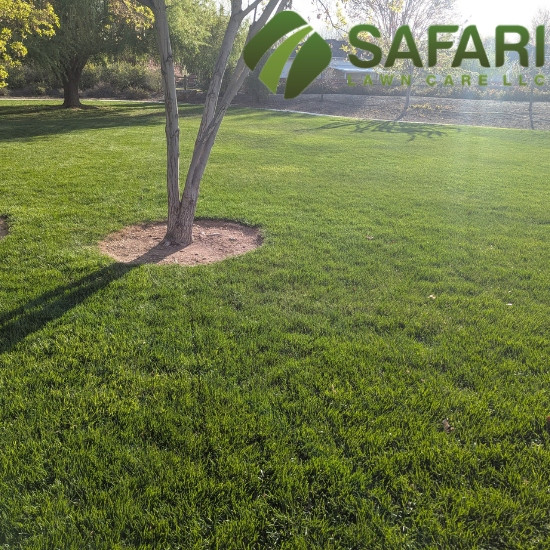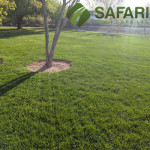Why Fall is the Most Important Season for Building a Stronger, Healthier Lawn
You can feel it in Boise the second September rolls in. Neighbors are busy raking leaves or tucking away their patio furniture for the year.
It feels like lawn care season is over — but that’s the trick. For your grass, fall isn’t the end of the year. It’s the secret season when the real work happens underground. And if you give your yard a little extra love right now, it’ll pay you back in spring with a thicker, greener, healthier lawn.
Here’s why fall lawn care matters so much — and a few things you can do now to achieve a thriving lawn.
Feed It
Think of fall fertilizer as your lawn’s version of Thanksgiving dinner. It’s not about packing on a flashy “summer body” anymore — it’s about stocking the pantry and building reserves for the long winter ahead.
In spring, fertilizer acts like an energy drink: fast green blades that look nice for a while, but roots don’t get much out of it. By July, when it’s 95 degrees and sprinklers are running nonstop, that shallow root system just can’t keep up.
Fall fertilizer, on the other hand, feeds deep. Cooler air and warm soil mean the grass is naturally pushing nutrients into its roots. That’s where the magic happens. Roots grow stronger, tougher, and ready to store up food. When snow melts in March, lawns that got a fall feeding bounce back earlier, greener, and thicker than the ones that didn’t.
So if you only fertilize once this year? Do it now.
Let It Breathe Again
Think about what your lawn’s been through this summer: backyard BBQs, ladder ball tournaments, kids running around, dogs chasing each other, the inflatable pool stomping one corner flat. All that fun comes with a price: compacted soil.
When soil gets packed down, it’s like your lawn is trying to breathe through a pillow. Water can’t soak in, nutrients get stuck at the surface, and roots suffocate.
Aeration fixes it. Those little plugs pulled from the ground might not look pretty at first, but they open the soil back up, let oxygen flow, and make room for water and fertilizer to actually reach the roots. It’s like hitting reset after a long, crowded summer.
And if you’re planning to reseed? Aeration is your best friend. Those holes are perfect landing spots for new grass seed.
Patch It Up Before Winter
Summer is hard on grass. Maybe there’s a bald patch where the slip-and-slide was. Maybe the dog’s favorite racing lane is worn thin. Maybe the hot spots near sidewalks and driveways just gave up in August.
Fall is your shot at fixing those bare or thin spots. Overseeding now, while the soil is still warm but the air is cooler, gives new seedlings the best chance to take off. They’ll settle in quietly through the winter and pop up strong in spring.
The bonus? A thicker lawn in spring means fewer weeds. Healthy, dense grass leaves less room for troublemakers like dandelions to move in.
Beat the Weeds While They’re Down
Most people think weeds are a spring problem. But here’s the sneaky truth: fall is actually the best time to go after them. Just like your grass, weeds are pulling nutrients down into their roots this time of year. So if you treat them now, it goes straight to the source.
That means fewer weeds popping up to ruin your spring yard. You’ll step outside in April and see grass — not a patchwork of dandelions waiting for the first breeze to scatter seeds across the neighborhood.
Don’t Let Leaves Smother Your Lawn
The fall colors in Boise are one of the best parts of living here. But the piles of leaves that drop on your lawn? Not so great. When leaves pile up, they block sunlight, trap moisture, and set the stage for mold.
That doesn’t mean raking has to take over your weekends. If the leaf layer isn’t too thick, just mulch them with your mower. Those tiny pieces break down and feed your soil naturally. Free fertilizer, no bags required.
But if it looks like a crunchy blanket out there, do your lawn a favor and clear it off before the snow shows up.
A Few Final Touches Before Winter
Once you’ve fed, aerated, overseeded, and handled the weeds and leaves, there are just a couple of last-minute chores that make a big difference:
-
Keep watering until the ground freezes. Your grass still needs about an inch of water each week.
-
Change up your mowing height. Lower the blade a little at a time until the final mow leaves your grass around 2–2.5 inches tall. Shorter grass won’t mat down under snow.
-
Clear out your sprinklers. Frozen pipes aren’t fun — or cheap. Get them winterized before the first hard freeze.
-
Take care of your tools. Clean the mower, sharpen the blades, and tuck everything away so it’s ready when spring rolls back around.
Why It’s All Worth It
It might feel like you’re doing extra work, but fall lawn care is more about working smart than working hard. A couple of hours now saves you weeks of frustration later.
Lawns that get the fall treatment don’t just survive winter better — they thrive. They green up faster in spring, hold water better in summer, fight off weeds naturally, and look good with less effort.
Don’t forget the patch of green that ties your whole home together. Give your lawn a little love this fall, and when spring comes, you’ll be glad you did. And if you're not up for that, you can always count on Safari Lawn Care for all your lawn care needs in Boise, Idaho.








